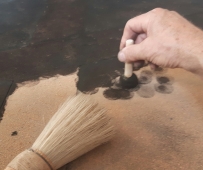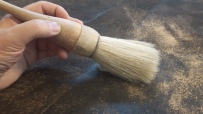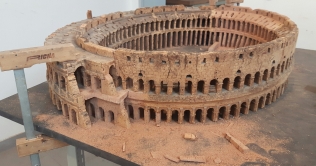… by Prof. Dr. Valentin Kockel
Not much is known about the life of Luigi Carotti. Models from his workshop are documented for the period from 1830 to 1850. During this time, he worked out of premises in Via delle Vite, and – before or after this period – in Via del Boschetto, as we know from the English labels on his models. Both streets are situated near Piazza di Spagna, where foreign visitors tended to take their lodgings when in Rome.
So far we mainly know of models depicting the ruins of Rome, the usual highlights of every visit: the Arch of Constantine, Colosseum, Temple of Antoninus and Faustina, Temple of Castor and Pollux, Temple of Mars Ultor, Temple of Saturn and the Column of Phocas. Amongst these, the highly elaborate and therefore costly Colosseum stands out the most. Carotti was able to sell this model at least three times. Compared to the models of his predecessors, it represented the actual state of the monument, as it showed the restorations of 1807 und 1823. The choice of depicting the hardly spectacular late Antique Column of the Emperor Phocas on the Roman Forum was probably due to the interests of English travelers: the column was first excavated during the French occupation and a second time in 1817 by the Duchess of Devonshire. The overall increased interest in Greek Doric architecture that prevailed in the 19th century is attested to by models of the temples in Paestum and Sicily.
Initially, Carotti’s models were probably bought by private collectors, but later became part of the collections of learned societies (Edinburgh, St. Petersburg) or museums (Cambridge and Altenburg). The Lindenau-Museum in Altenburg (Thuringia) is the only institution to hold a larger number of models with eight specimen, amongst them a well-preserved Colosseum. Individual models have appeared on the art market, often heavily fragmented. One of these was the model of the Colosseum that is now held by the Piraneseum (San Francisco) and is being restored by Dieter Coellen.
Carotti’s work occurred at a time when interest in cork models was already on the decline. In Rome, he seems to have been the last of his profession whose oeuvre we can still follow at least fragmentarily. Compared to the works of Chichi and Lucangeli (Rome), Padiglione (Naples) or Georg May (Germany) his models appear somewhat dry. Apart from using massive cork as primary building material, Carotti utilized reddish, fired terracotta elements for ornamental details, such as friezes and capitals of the Corinthian order. Their colour has often faded away, but would originally have produced a strangely spotted effect.














 .
.









